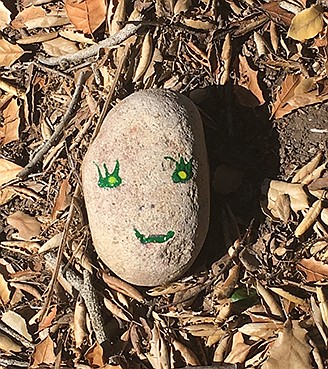 Facebook
Facebook
 X
X
 Instagram
Instagram
 TikTok
TikTok
 Youtube
Youtube

A low-grade tag war broke out a couple of months ago on the retaining wall in front of a burnt-out motel near my home. Three letters — initials, surely — spraypainted by some poor soul seeking to make his mark on the world. I don’t remember what the initials were, because they were not memorably rendered. What I remember is that some other poor soul spraypainted a line through them and then applied his own tag to the wall — only to have the first artiste return the favor. And so on, until the city came and whitewashed the whole debate. Maybe it was a turf war; maybe the initials marked who got to sell on that corner. But to me, it looked like a baseline assertion of self: “This is me. I was here.” “No, I was here.”
It put me in mind of Harry Crane from the TV series Mad Men, talking about his fascination with the cave paintings of Lascaux. “Seventeen thousand years old. The bison get all of the attention, but there are also all of these hand prints with paint blown all around them. Like someone reaching through the stone, right to us: ‘I was here.’” Except minus the bison, and minus even the artistry on the signature.

And that put me in mind of Orson Welles’ great monologue on Chartres cathedral in F for Fake. “The premier work of man perhaps in the whole Western world and it’s without a signature… ‘Be of good heart,’ cry the dead artists out of the living past. ‘Our songs will all be silenced. But what of it? Go on singing.’ Maybe a man’s name doesn’t matter all that much.”
There is no signature on the rock-pile installation that runs along 26th Street as it descends through Golden Hill Park toward Pershing. It’s just things put on top of other things, again and again, but it’s almost absurdly pleasing to explore. (Chartres is a more orderly pile of stones, but the echo is there.) The piles are not stable; some have already toppled. Unlike Lascaux, they will not endure. But like Lascaux, they express some artist’s vision, and like Lascaux, the collection is accompanied by something human: a face. Several faces, actually, painted on single stones along the trail. In perfect opposition to the tagger, the artist here doesn’t need to be known; it is enough to say, “This was no happy accident. I was here.”


A low-grade tag war broke out a couple of months ago on the retaining wall in front of a burnt-out motel near my home. Three letters — initials, surely — spraypainted by some poor soul seeking to make his mark on the world. I don’t remember what the initials were, because they were not memorably rendered. What I remember is that some other poor soul spraypainted a line through them and then applied his own tag to the wall — only to have the first artiste return the favor. And so on, until the city came and whitewashed the whole debate. Maybe it was a turf war; maybe the initials marked who got to sell on that corner. But to me, it looked like a baseline assertion of self: “This is me. I was here.” “No, I was here.”
It put me in mind of Harry Crane from the TV series Mad Men, talking about his fascination with the cave paintings of Lascaux. “Seventeen thousand years old. The bison get all of the attention, but there are also all of these hand prints with paint blown all around them. Like someone reaching through the stone, right to us: ‘I was here.’” Except minus the bison, and minus even the artistry on the signature.

And that put me in mind of Orson Welles’ great monologue on Chartres cathedral in F for Fake. “The premier work of man perhaps in the whole Western world and it’s without a signature… ‘Be of good heart,’ cry the dead artists out of the living past. ‘Our songs will all be silenced. But what of it? Go on singing.’ Maybe a man’s name doesn’t matter all that much.”
There is no signature on the rock-pile installation that runs along 26th Street as it descends through Golden Hill Park toward Pershing. It’s just things put on top of other things, again and again, but it’s almost absurdly pleasing to explore. (Chartres is a more orderly pile of stones, but the echo is there.) The piles are not stable; some have already toppled. Unlike Lascaux, they will not endure. But like Lascaux, they express some artist’s vision, and like Lascaux, the collection is accompanied by something human: a face. Several faces, actually, painted on single stones along the trail. In perfect opposition to the tagger, the artist here doesn’t need to be known; it is enough to say, “This was no happy accident. I was here.”
Comments